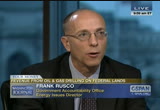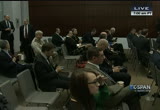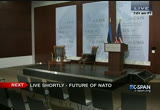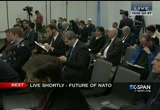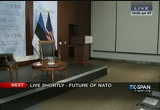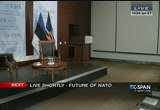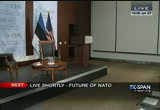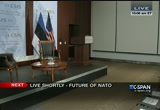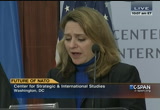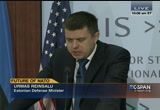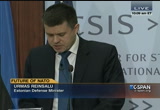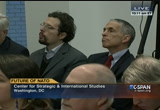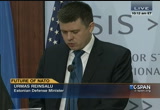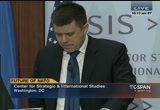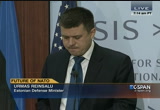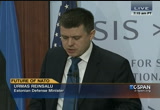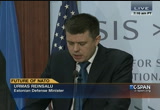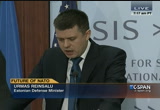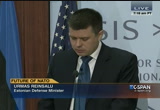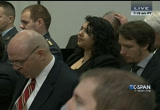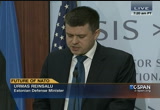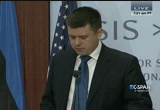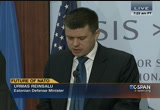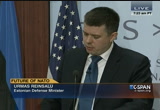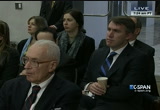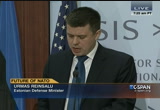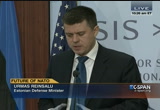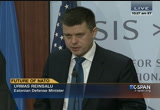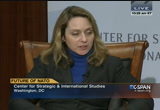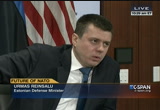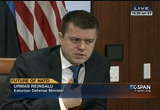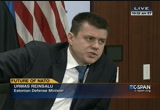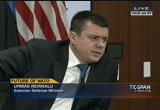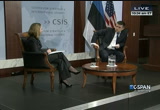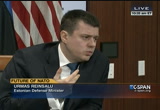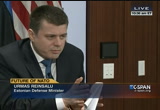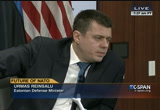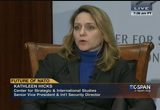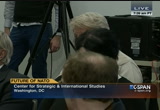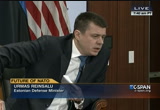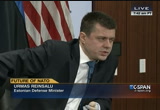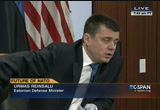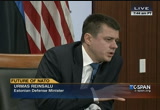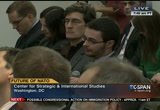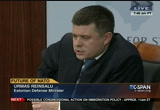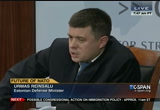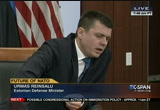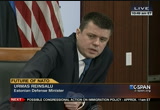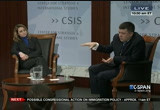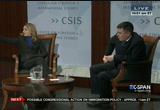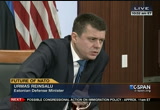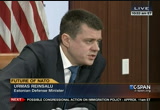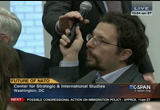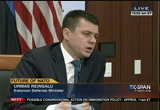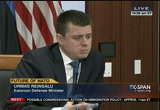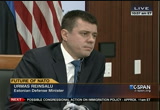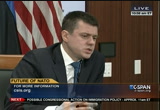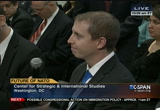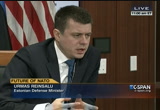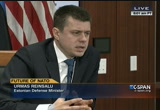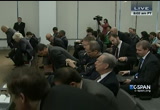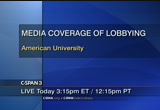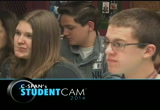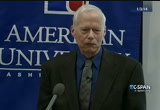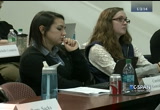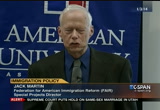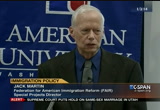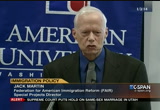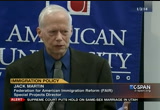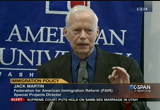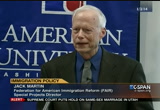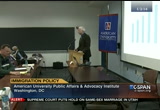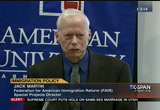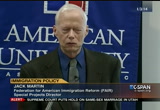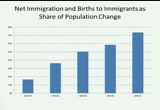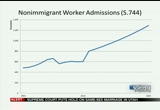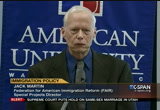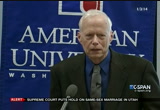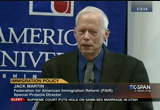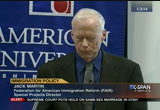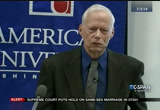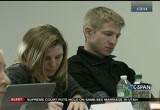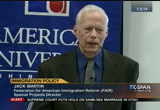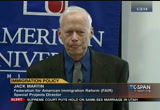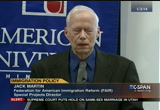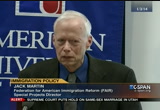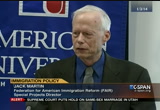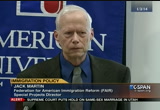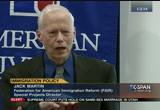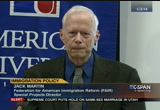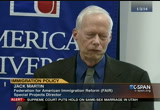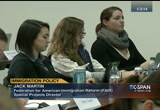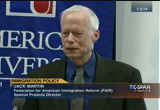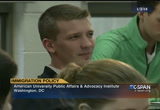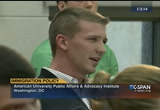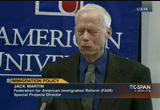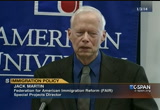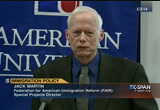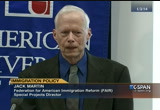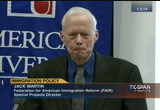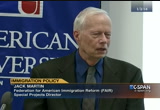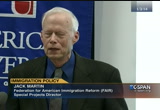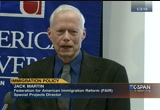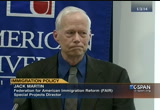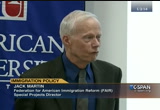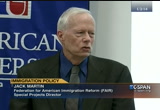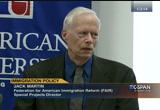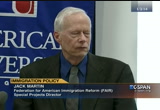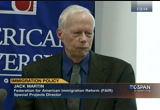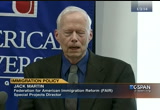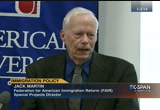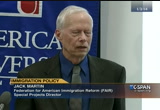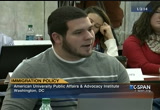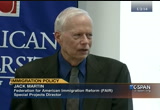tv Key Capitol Hill Hearings CSPAN January 6, 2014 10:00am-12:01pm EST
10:00 am
the land that is regulated is 260 million acres. offshore for the outer continental shelf, the water area that is federalas 1.7 bill. it is a very large amount. in addition, the federal government has jurisdiction over mineral rights. it is a very large part of the country, especially in the western states. host: thank you for being with us this morning. guest: thank you. it has been a pleasure. host: we are going to go live to the csis, where they will be discussing 12 years in afghanistan, 10 years and nato. [captioning performed by national captioning institute] [captions copyright national cable satellite corp. 2014]
10:02 am
>> this morning, the defense minister of estonia is scheduled to speak about the future of nato. the defense minister is expected to address defense priorities, security challenges, along with the current nato operations. nato was formed in 1949, with estonia becoming a eight -- a member state in 2004.
10:06 am
>> we are live for remarks on the future of nato. the defense minister of estonia is expected to address defense priorities, security challenges, along with current nato operations. , here inosted by csis washington. it is expected to get underway in just a moment. we will show you a roundtable talk on the congressional agenda from this morning's "washington journal." good morning, ladies and
10:07 am
gentlemen. thank you for making it hereto csis. program the security here. i am not heather connolly. florida,as trapped in of all places, by canceled flights yesterday. in good news is she ended up a place with the warmest weather in the u.s., the bad news is, there are no flights going there, so she could not get out. i have the pleasure of introducing urmas reinsalu. the minister of defense since may of 2012 and has been a member of the parliament since 2003. prior to 2003, he was a lecturer at an academy and has held a number of positions in the estonian government. we are privileged to have him
10:08 am
here to discuss defense priorities and military modernization plans ahead of the september 2014 nato summit. after his remarks, he and i will discuss issues relevant to estonia's defense and then we will open up to questions from the audience. lee's join me with a round of applause for urmas reinsalu. [applause] thank you very much for warm, welcoming words. i am coming from the nordic country where we are having an exceptional situation. we do not have snow. here and ited to be am very proud that among us are to helicopter pilots from estonia's air forces, who have
10:09 am
served in afghanistan with you and now serve in the maryland national guard. i welcome you here. we will mark a number of important --. sarajevo andce outbreak of world war i, 70 years since normandy, 65 years since the washington treaty was signed. a quarter of a century since the and 15, 10, and five years since the cold war enlargements. it is a moment for us to look back at what we have achieved. nato, along with the european union, was a natural choice for estonia after regaining
10:10 am
independence in 1991. membership in western organizations is seen as the coppola of estonian security. this was a great engine for reform back in the 1990's. last year, 76% of estonians supported them are sure. the population believed that defense forces should participate in international military operations when they can. i am proud to say that all the , it has been an consensus vote in parliament. the cause of our history, people remember peace and security -- because of our history, people remember that peace and security do not come free. weshould not forget that
10:11 am
still need to maintain our defense capabilities and contribute to their lives. there have been discussions about nato's role, but we must keep in mind what has been achieved. with the end of the cold war, global security environment changed almost overnight. nato adapted to it. of theout the period cold war, nato forces were not involved in a single military engagement. since that time, they have engaged in missions that cover the spectrum of crisis management. today, just under 100,000 military personnel are engaged in nato missions around the world. nato continues to provide multinational command structure
10:12 am
capabilities. it is the most powerful military alliance in the world. it hasn't always been easy. many soldiers have lost their lives, including nine estonians in afghanistan. nato has proven that it is able and willing to adapt to reform and prove that it is still relevant. nato has been an adaptable organization. decisions made during different rounds of enlargement are proof of that. the risk to take and seven more eastern european countries a decade ago turned out to be a worthy one. the security of the planning community has improved through enlargement of nato. however, we cannot take this achievement for granted. security needs constant commitment and improvements, especially in the unpredictable
10:13 am
and complex world. nato has to remain active and find ways to engage more. summit in the coming months, we must confirm the we value -- confirm that we value contribution and we remain open to new members. consensust a understanding today. we should encourage and help countries so that they can prepare better for the next membership. the -- to see up, among we wish to see, among the conclusions of the nato summit, a recommitment to the two percent spending sensible. -- principal. today, five countries out of 28
10:14 am
spend less than 1% of the gdp to defense. than 175 --end more 1.75%. only four countries crossed the 2% threshold. 1990's, it was 12. if the negative defense spending trend continued, nato's military capabilities and political credibility could be put at risk. outraged bywe are the cost of war, but we are more outraged by the cost of peace. we should not consider europe as but thateneous area, all the countries think and act at the same time. the countries of
10:15 am
that understands the necessity to continue to contribute 2% of gdp to defense and who actually does so. when i became minister in 2012, it was the first year that we contributed 2%. we will remain at that level. is toggest difficulty sustain that level when many others do not respect their commitment. importance that 2%.nato summit reaffirm the we need to keep this as a goal. stating this goal will not instantly changed the defense budgets in europe. versa, it will that benchmark- and will bring additional cost.
10:16 am
at the summit, nato must reconfirm its commitment to --. and --ticle five article. the baltic region is the only military's or the strategic balance is not favor the allies. because of our good friend, russia. ensure nocontinue to outside powers tempted into making a miscalculation. the good work we have done in demonstrating political unity and decisiveness must continue.
10:17 am
contingency planning and conducting exercises on a regular basis, second, sending an ambitious, clear, and consistent message to third parties. both contingency planning and exercises should be a normal and routine part of nato's work. third, the continued stance of the transatlantic link is also one of the main topics of the summit for us. we wish to see the u.s. committed to europe and the european allies committed to a fairer burden sharing. europe a challenge for and we will remain to arise the question among our european allies. burdens a question of sharing inside europe that needs to be addressed.
10:18 am
many are frustrated with european level of distance -- of spending.- of defense we should not forget that between 2007 2011, an average of 13 to-- an average of 40,000 --.0,000 to area of theother world that contributes to such a military operation. the last u.s. tank departed from europe in march 2013. i don't know where that tank is, but we miss that tank. understand financial
10:19 am
difficulties that you face, i have to underline the importance of american presence and visibility in europe and in the baltic region in particular. it reinforces nato's credibility. in times of diminished resources, having allies willing to share the burden becomes more important. this seems to be commonly ignored. survey, onlythe natof americans felt that helps countries share the cost of military action and only 12% of europeans said the same. room fora lot of improvement. we have run out of money, and now we have to think.
10:20 am
in the baltic states, we have practiced smart defense for more than a decade. i was not -- it was not because we're smart, but because we are small and poor. officers of the free countries are trained in the one single , baltic defense college, since 1919. we have an air surveillance system and a common mine countermeasure unit. send a balticll battalion to the nato response force. wider than just the free baltic states. i could mention the nordic allle group which includes who canbaltic countries
10:21 am
contribute. finland, sweden, ireland, latvia, lithuania, and estonia. we also coordinate our in international military operations. we take part in utm. we are in discussion about our contribution for support in afghanistan. another topic will be the .reparedness and ability the alliance is currently at the pentacle of our interconnectedness. the glue will start to one stick.
10:22 am
to avoid that -- the glue will start to unstick. to avoid this, we must practice on exercises. it is also important, politically, as additional straights -- as it demonstrates continued relevance. the connected forces initiative is one of the core issues for estonia. we hope to see a robust, forward-looking program with annual live exercises put in place. these exercises should take place all over the alliance on both sides of the atlantic. about the latest nato exercises, , a live exercise took place in poland and in the baltic states.
10:23 am
-- was the first large-scale article five live exercise since the cold war. that also worth mentioning this time, allies exercised defending their country. we have sentimental feelings about that exercise. scenario for solve the defense by thenia bayou via -- alliance, nato has been preparing for that from more than a year and we are better acquainted with our region and its security challenges. [indiscernible] nato forces the ability to exercise. our long engagement and counterterrorism type wars in
10:24 am
pain -- and failing states has changed our mindset. it has driven us away from the collective defense approach. the country, who was the biggest contributor was france. had 1200 participants. the second was poland who contributed 2000 -- 1000 troops. bronze medal, same level, was to the u.s. and --. both contributed with a -- size unit. it was an honor for us to host the cyber defense exercise. it was the first time this
10:25 am
exercise took place outside of shape. it involved 400 people in 32 different countries and was a success. we hope to continue hosting such exercises in estonia as training and exercises are clearly supporting our nation and also nato's capability development. we are gaining experience in this field and are interested in the infrastructure development which should be shared with other allies. thatia has understood ciber is an integral part of the sith -- that cyber is an capabilities.of cyber shouldhat
10:26 am
play a bigger role in future exercises. military engagements have given us more than just a dash. they have given us a trust for -- a trustful relationship. trusted relationships take years to build. connections are only available because you have gone to school together or because you have endured hardships together. relationship that we have built with the u.s. on the field of afghanistan and iraq. combat can replace experience side-by-side care and we wish to maintain this link after the end of the mission and find new openings for cooperation. up,ome, -- to sum it all
10:27 am
estonia hopes to see a balanced nato capable of filling its tasks. collective defense, second crisis management, third corps parade of 60 -- third, while printed security. -- cooperative security. we don't see a need to make revolutionary reforms, but rather focus on core tasks and improve national contributors. a region pessimism about the success of the nato mission in afghanistan, and continued debate about european contributions to burden sharing, 55% of americans and 58% natoeans seen nato -- see
10:28 am
as necessary for their country's security. -- wasain value will be to be an alliance of democratic country such back together. -- countries that should act together. thank you very much. [applause] >> thank you for that speech and talk. i think there is a lot here for us to dig into. of thest i think comments you made that i was struck by was the recommitment to the two percent metric. that is something that we struggled with in the alliance for some time. the real question is -- how can
10:29 am
we be persuasive on this? if we use your thought that might beaving it, we in more of a freefall than was happening -- then with having it, what do we do to persuade the countries that are not currently making the 2% in the absence of an overwhelming threat. think those of us who are making the mark can do to be persuasive to other countries? >> i try to avoid being provocative. >> provocative is a good thing. >> not in nordic countries. i think what is important is to applaud the success stories. in nato and european union, i hear the sayings that we have a
10:30 am
prisoners dilemma. we try to balance during the crisis, wefinancial have to make cuts to defense. estonia has proven it is possible to do them both. hese are not contradiction ary aims. we have a balanced budget. we have the smallest national debt in the eu and we have been succeeded in -- succeeded to move against the ties of europe. when countries are doing cuts to defense spending, we are doing vice versa. we are creating more -- recruiting more men and women into the army, and buying more weaponry, etc..
10:31 am
we are not doing it for fun. this is our view of security. a small country needs to be a net provider of the security. cornerstone ofa the way to show the european allies the way forward. a clear ands that sound message is what the u.s. has given. secretary hagel clearly put the message that europe has to understand that this will not be sustainable. domestic seen in the u.s. will one day -- because of the viewpoint of --. has european allies have to understand it and not returned
10:32 am
to -- turn to nato was such a negative sera there -- negative scenario. smartt brings to mind defense and how countries can contribute and the baltic seminar that states have had this great example already. what lessons do you think the baltic cooperation, what lessons can that provide to other states in europe who are looking are smart defense approach? about therried overusing the word smart defense in a way of excusing the defense cuts. it doesn't matter how much money
10:33 am
we put in. is alsosomething that commonly heard. the -- to positive thing, like self-evident, but the smart defense, i think were a good example of smart defense from permanent air policing over the baltic sky. i am happy to inform you that for me last friday, the u.s. pilots and planes are taking their duty to defend estonia and latvia and lithuania. i am positive about a security and defense dimension of the european union.
10:34 am
i think the joint procurements and programs of developing certain new security, weapon systems have turned to be successful once. >> you mentioned the u.s. air force for dissipation in the baltic air policing and also spoke about the last u.s. take -- tank leaving europe. what are the most critical u.s. capabilities for defense of european territories? focus itselfu.s. on if it needs to focus, in capabilitiesiding forward into europe? what makes the most impact with you and your public? in our region, it is a special area because we are the
10:35 am
nato where we have capabilities. the most important is a complex of different actions which could presence. as a , visits, arcises clear and sound political statement when they are needed. surely, the crown jewel would be the permanent presence of the u.s. troops in european soil. i would be pleased to see a
10:36 am
permanent u.s. presence in my homeland, but i understand the reality today. baltic countries are special presenceas much as that the u.s. could produce, i think as efficient as it will be also to encourage european theiries to for so responsibility -- to fulfill their responsibility. domestic scene looks that european countries are out, and european countries are moving towards the pacific, this is something we have to avoid, both ships are going far away from each other. >> what is your sense of the u.s. rebalance approach and how
10:37 am
it is being received in europe and have the u.s. has spoken to europe about its strategy. ? is a worrisome? is it understandable? the u.s. takes it seriously that they need to explain what their agenda is. senator hagel has given a very sound comment on that. surely, especially eastern , the u.s. astries being a shown actor in the area will be a consistent one. theink we understand
10:38 am
financial challenges on the u.s. presence couldt mostoduced in the cost-efficient way, especially in our region and we would be very much appreciate in coming on the agenda for alliance or bilateral cooperation. >> let me open it up to the audience. we have a few folks with microphones, when on you if you can tell us your name and your affiliation. we will start in the back. >> hi.
10:39 am
i am a regular around here. i have watched nato from the and my thinking, i have managed to divide it into two organizations, separate. i called a micro and macro. the first, mike rowe, -- the , existed whenato there was no fighting done, no warring. was when the expansion began to take place, when we started to bring people miles away from the north atlantic. from an outsider standpoint, that macro nato has become an antagonist or an aggressor. is that some of the reason you
10:40 am
think people have started to back away? am i correct? i might not be. mentioned natoou since the beginning, although you look younger than 65 years. tell my country's viewpoint on international missions. thestonia, we explain to public why we are broad and why women tour boys and afghanistan, iraq, africa, why we're doing it. sake ofoing it in the the liberty of our country. they're defending the liberty of our country there and they are doing it so that the most practical way is to solve the
10:41 am
re the in the area whe crisis occurs. if the crisis is bigger and bigger, it will put to the ha ndcuffs nato and the allies to act. this is something i will not this is position to say something like we see as an aggressor. in all cases, we know that the humanitarian need and democratic values, why nato acts in rios, those are to mystified understanding of the principles of liberty, dignity of humans.
10:42 am
>> think you. all the way in the back -- thank you. all the way in the back on the other side. >> you mentioned that the baltic is the only region in europe from aato suffers minority position where the balance is against nato thanks to russia. where does the balance work on behalf of russia and against nato? >> i will mention some figures. balancew that a certain region is turning in coming times.
10:43 am
in favor of the nato allies in the region. years,mthe four last russia has doubled its strategic weaponry in our region. say that the state partook in about 6000 nato troops was scenariost article 5 exercise after the cold war. so was -- 2013. , aggressivegest some are now based off of the west exercise after the cold war. bothstimate took part together,oops and all
10:44 am
about 100,000 troops. there are lists of different activities from the russian side that we see in a historical sense in the western dimension and military region. in russia, this is one of the priority regions of russia. in addition to that, and has been turned a priority to the future way. whether it will be a danger or not, this is a -- political question. from a military viewpoint, we understand that the balance is not in favor of nato in our region. this is a reality.
10:45 am
thank you. >> a question, right here. when you mentioned the kinds of things the united states can do to ensure the u.s.'s commitment to nato security, you did not mention the presence of tactile a call -- tactical nuclear weapons in belgium and turkey. with the end of the cold war and declining defense budgets here and in nato member states, keeping those things in mind, do you think nato can adapt its nuclear sharing arrangement with and what steps can the u.s. take to ensure nato security without the presence of tactical nuclear weapons in europe? would say i am a realist
10:46 am
nuclear weaponry and the nuclear power balance. looking to the tactical nuclear weapons, also. nuclear deterrence is needed for nato. didn't mention it in my speech, i will do it now. very valuable -- which the u.s. produces for the security of the alliance. the reality is that nuclear is very clearly seen in 's defensen federation
10:47 am
strategy. there have been comments that the u.s. -- diminished nuclear weaponry. thes only because of weaponry that the u.s. will have more power. that the russian federation, looking from our region's viewpoint, will have nuclear weaponry in their strategic military thinking using the tactic nuclear weapons if the situation will demand it. very sound way to use it from the military landing .iewpoint
10:48 am
this is something we are aware. thank you. >> does the doctrine seem to be moving into a nuclear dependent approach? are, what areu the most worrisome trends in terms of russian military thinking? what worries you the most? think, something, i want to not be paranoid. the danger of the military actions or conflict in our today.is very low reality is that what we see russiantic is that in
10:49 am
strategical thinking, to achieve the political aims military meansp is quite justified. taryndly, for their mili thinking, the main danger is a military attack from the west side, from the nato side to russian soil. this is a second one. thirdly, i think this problem is the lack of transparency in their way of thinking and decision making and the way globaluld achieve
10:50 am
politics. b our region, the military negative minor or compared to the russian federation troops. situationsoduce the -- where a dangerous situation could appear, not because of visa the problems between russia and estonia or russia and latvia, but because it is an area where it would be easy to take rebalance in the global situation. if there appears a conflict between the russian federation and the u.s. or nato. the russia, in tv, they
10:51 am
started public discussions and crisis was inn the peak and the solution was discussionshere was about whether the u.s. was going to send missiles. in russia, there was discussion, should we, to balance the situation, should also take some parts back from latvia and we would like to make a repayment to the u.s. then. it is intriguing. >> all the way over here.
10:52 am
>> i want you to touch briefly on european defense policy and dppand on how you assess es and whether it is resulting in duplicate structures that duplicate what exists in nato. which is onsue discussion in the european union. the heads of state discussed at last december. i was quite satisfied. from the signla thaal that union, water ration is ration --a whopper
10:53 am
cooperation is needed. going toean union is work on military capabilities as therdly, i think minority of the country's belong to the nato and european union, i think the very logical with be not to duplicate, but to standardize different actions. logical if wevery are speaking about cyber defense. that level of cyber defense of the european union institutions natod nato institutions, headquarters should be the same. crisis, it of major is more productive.
10:54 am
i think the u.k. is very strong, too strong of a watchdog. union has not developed its military security corporation. it is always finding a balance. knowing have turned a step forward -- now, we have turned a step forward. >> we have time for two more. i wanted to ask you about your thoughts on the recent failure to engage with the ukraine on the part of the european union and you believe this will make more certain the need to expand its own of allies and friends in the region. >> for estonia, and eastern european countries to go to the
10:55 am
10:56 am
ukrainian situation is very clear. i think we understand what the .utin plans he wants to build on the ruins of the former soviet union the where ak of countries strategic role surely plays ukraine. meansre using all of the to achieve that aim. i think what is very important andhat the western leaders also the public audience should send a very clear message. the first message is to kremlin that it is unacceptable to in
10:57 am
fluence the dependent countries to make me options -- to make the options about the nation's future. the second is that it is unacceptable to use violence against its own people. this is the message that needs to be given to you on a covert. to janokovich. fragmentedn is also and you have to be careful with red lines, where you put it.
10:58 am
opposition has demanded several ifferent issues, but i think the opposition is able to get the different structure and think it united, i too.be a real challenge suspcious that they would move the country to europe. he will not go. be iserent question would not a case where europe union of values could take one country just on the principles of money
10:59 am
or the need of money. this is not a -- not just a marketplace, but this is a union for europe and the fatal mistake that they have made. >> final question. right here. i appreciate your comments on restrictions for nato, looking forward the -- forward to the summit. can you elaborate on your die reveries- domestic -- domestick i'm priorities? you mean the military capability priorities? for our first, it is most
11:00 am
reaction, rapid capability force, what we have learned from the trojan war, what we have learned from the philosophy of modern warfare, the rice is occur within days. we need to be ready to act. to give our allies a chance when the 2 -- collective defense a chance tole v, past decisions and make logistical movements. in estonia, as we are moving against the tide in investing. there is one element where we are in the modern world in a minority group of countries. we believe strongly in national construction system -- we
11:01 am
believe strongly in a national conscription system. after we joined nato, there was the economy -- the academy discussion, whether it was practical. 90% of estonia reported, not because it is cost efficient to hold a reserve army having rapid reaction capability. is also a strong moral dimension. free men are taking the duty to defend their country. very importantng to estonians. very strongly because of our historic reasons. is, during the next 000ade, to establish 21, rapid reaction troops in the
11:02 am
army. within ach the button, very short timeframe, we will have such an army. it was based on the reserves system. >> thank you. >> thank you so much for covering such a great amount of ground with us. for your talk and for your interaction and also for the great partnership and alliance that we have with estonia. and he's very much, please join me with a round of applause. [applause] i was very privileged to be here. to receive you here, thank you very much. thank you.
11:03 am
[captioning performed by national captioning institute] [captions copyright national cable satellite corp. 2014] >> liz cheney, daughter of dick cheney, announced that she is abandoning her efforts to unseat republican incumbent mike enz i, citing health issues in her family as a reason for her decision. she moved her family to wyoming for the seat. politico reporting that wisconsin republican ron johnson plans to file a lawsuit against the office of personnel management over its policy permitting lawmakers and health hill staff to get obamacare subsidies. he is holding a news conference
11:04 am
just over an hour for now -- from now. the senate begins the second session of the 113th congress today at 2:00 p.m. eastern, senators will debate long-term unemployment insurance. at 5:30, they will debate the nomination of an ill and to head the federal reserve -- of janet yellen to head the federal reserve. session, weack in will have live coverage on c-span. starting at 2:00 eastern, live from the brookings institution threatiscussion on the of cyber warfare. journalists will take part. 's new seniorpr washington editor will be speaking at an american coveragey about media of lobbying. that gets underway at 3:15 eastern on c-span3. the issues you
11:05 am
would expect. we are focused on innovation. we want to make sure innovation is a national strategy and american companies can keep introducing the greatest products in the world. we dominate and so many areas. we have a lot of ford motor to nationals -- we have a lot of foreign multinationals and we want to continue to be the leader, requiring great immigration policies. it also requires a rational patent policy. you can invent things and you're not being sued. of the consumer electronics association, gary shapiro, tonight at 8:00 p.m. eastern on c-span2. the deadline is approaching for c-span's student cam video competition. what is the most important issue congress should address this year?
11:06 am
with a five minute to seven minute documentary. $100,000 in total prizes and a grand prize of $5,000. and trees are due by january 20. get more information at studentcam.org. >> immigration policy -- possible action in congress. jack barton spoke about this at american university last week. his group advocates for reduction in the tide of illegal immigrants. this last about one hour. good afternoon, i am pleased to see all of you made it through the snow today. let me first of all give you a little background, personal background and a little bit of background on my organization before we get started. i am a retired foreign service officer.
11:07 am
i had 28 years in the u.s. department of state as the u.s. diplomat. i've served in england. i've served in morocco and in sudan, in mexico, i've served in nicaragua, in paraguay. and as part of that i was trained in immigration law because as a consular officer, which i did during part of that service as a foreign service officer, that's involved in issuing visas, it is involved in u.s. citizenship issues, things of that nature. i have issued immigrant visas. i have issued and rejected non-immigrant visas for people to come to the united states. i've worked on getting border crossing cards for mexicans to travel to the united states. this was some of my background
11:08 am
from my professional career as a government employee before i ever got involved in the immigration issue in a non-profit. after retiring from the state department, a couple of years after retiring i got involved in the immigration issue. as the research director for the center for immigration studies. that is a small non-profit organization in washington, d.c. that works basically entirely on research studies. as immigration was reaching sort of a crescendo point in terms of legislative change in 1996 i shifted from the center of immigration studies to federation for american immigration reform which is an activist organization because i wanted to be involved on the activist side of trying to
11:09 am
influence that congressional debate. and to try to get legislation adopted in 1996 that i thought was important for the future of the country. that is a little bit of my background. with regard to the organization fair, fair was founded by a group of people that were involved very much in the environmental movement in terms of trying to stabilize u.s. population, trying to limit u.s. population growth because they felt that was in the national interest in terms of natural resources, in terms of crowding, in terms of assimilation, things of that nature. and it is true to that purpose today, that is in effect our roots. at the present time however we're not dealing that much with
11:10 am
the roots issue per se because so much of the debate about immigration at the present time is centered on the movement in the u.s. to try to adopt comprehensive immigration reform which i believe you have been informed about is a combination of issues. it is often described as a three-legged stool in terms of one leg being enforcement, another being amnesty for the illegal immigrant population and the third stool being an increase in immigration. we are in favor of greater measures to try to deter illegal immigration to the country but we are also opposed to any increase in immigration and actually think it ought to be reduced.
11:11 am
we think that those measures are very well understood. they are well understood in congress. there is general agreement on both sides of the aisle in congress that we need to do more to effectively deny job opportunities to people who come into the country illegally. that is something that was recommended in 1996 and i worked for. it was included in that legislation. congress told the immigration authorities that they had to set up a system for controlling against illegal immigration by in effect allowing employers to be able to tell the difference between somebody who was legally in the country and a person who was not on the basis of the documents that they present when had they applied for a job. earlier than that, it had been required since 1965 that all employees, new employees had to
11:12 am
complete an i-9 document with the employer in which they identified their social security number. they had to identify their date and place of birth. and in that way, in theory in 1965 that would have presented -- that would have prevented illegal immigrants from getting work in the united states. but it didn't work because there was no way for employers to verify that documentation. as a result there was a widespread -- well, as a result of the 1969 reform that said that employers have to verify these documents -- i'm sorry, it was a voluntary system that allowed them to verify these documents but because it was voluntary most employers didn't bother to sign up for it. and as a result the illegal
11:13 am
immigrant population in the country continued to use fake social security numbers, fake drivers licenses, fake immigration documents in order to continue to satisfy employers requirement to not knowingly hire illegal workers. that continues to be an agenda item of making that verification , known as e-verify, a national mandatory system. as i said, there is general support for that on both sides of the aisle in congress, but it is not passing. separate bills have been introduced to make that a national mandatory system but it has been opposed by those in favor of a comprehensive approach, which includes amnesty for those illegally in the country at the present time. they said they will go along with that if that amnesty was
11:14 am
adopted and that was one of the provisions in s-744 which passed the senate last year. that basically talks a little bit about the agenda of my organization at the present time. but let me go back again to the starting point of why we are concerned about immigration at the present time and what the idea of immigration limitation is all about. first of all, where is my computer? right here. first of all, i just want to show you the fact that the united states has a very large growing population. up until the last few years when we had the economic downturn, the population was growing by about 1% per year, by about 3 million a year as our population
11:15 am
neared 300 million residents in the united states. if any of you remember your math, 1% per year population growth rate implies a doubling of the population in 70 years. so in effect, had we continued to keep up a rate of 1% per year, we would have been looking at adding another 300 million to the population in your life times. imagine what that would mean in terms of crowding in terms of , traffic, of need to build more highways and land resources. but that is a very high rate of population growth and it is the highest rate of population growth of any developed country in the world. let me turn for a second to the
11:16 am
foreign born population share of that population increase. as you can see, it is a much steeper curve in terms of population growth. that is because of the fact that as a result of the immigration reform adopted in 1965, we have had increasing immigration every year since then. in theory, the 1965 limits were set and continued to apply, but those limits are not comprehensive. a major portion of our immigration intake system is for immediate relatives of u.s. citizens and there is no limit to that category of immigration and therefore every year it has continued to increase. what that means in terms of a
11:17 am
foreign born population that is increasing in the united states and one that is generally younger than the overall u.s. population is that that population also tends to have a much higher birth rate than native born americans. part of that is because of the fact that many immigrants are coming from cultures in which larger families are a norm and part of that is because of the demographics the immigration population tend to be a younger population in child bearing years. in any case we have this growing population of as a result of births through the immigrant population in the united states. as a result while this is also -- this is also the issue of immigrant admissions that i referred to in terms of being
11:18 am
increasing. the blue line, the spike there is the amnesty provision that was adopted in 1965 that led to the legal status given to about 2.8 million illegal immigrant who were in the country at the. -- at that time. as you can see, absent that we have had a steadily growing immigrant population. when we take the births and -- let me take the next point. when we take the births and the admissions we get a much higher share of the population growth being due to immigration every year. this is temporary worker admissions. this is immigrant admissions projected if the senate bill were adopted.
11:19 am
s-744. this is in accordance with information that was provided by the congressional research service analyzing what that legislation would do. it would increase legal immigration. it would give legal status to the illegal immigrant population currently in the united states. and as i noted in this chart it would also increase the number of temporary worker admissions coming into the united states. so we have at the present time more than a million legal immigrants being admitted into the country for permanent residence every year. now, that is a very large number. as a result of the immigrant admissions, the births to the immigrant population, immigration today is responsible for about 75% of our annual population growth. and the pew hispanic center has
11:20 am
estimated that if the current trend continues, that over this decade that immigration will be responsible for 82% of the nation's population growth over that decade. so if you would be interested in trying to stabilize population, it seems very clear that there would be no way to do that without reducing immigration simply because it is by far the major component in population increase every year in the united states. now let me just shift for a moment also. there are basically two ways of looking at the immigration issue. i've talked a lot about the numbers associated with immigration, the number of immigrants coming into the
11:21 am
country, their share of population growth, their share of births in the united states. the other way of looking at immigration is the way that i think that probably most of you have tended to look at immigration and that is thinking in terms of immigration in terms of perhaps yourself or perhaps your parents or perhaps friends or relatives or neighbors or maybe thinking in terms of the valedictorian of a high school whose parents were immigrants and never had more than a high school education. or perhaps thinking in terms of refugees who we admit to the united states in keeping with our tradition as a nation of immigrants. in fact, we admit more refugees for permanent residence in the
11:22 am
united states than the rest of the world combined. but that is looking at the issue of immigration from the personal, from the individual perspective. and i was thinking about how to characterize the difference between these two perspectives, between the numbers and the individuals and looking at the individuals. so i did a little research this morning and i found a wiki quote that sort of summarizes the situation. it said "one should not lose sight of the forest for the trees." what does this mean? "a forest is full of beautiful trees for the beholder, but one become so engrossed in looking at the individual trees that they may forget that each tree is merely one of thousands in the forest and lose sight of the big picture."
11:23 am
that is basically the difference between those two different perspectives. most of the people who are on the side of the comprehensive immigration reform debate are looking at the immigration issue from the perspective of the trees, of the individuals. they are looking at perhaps the perspective of an employer who wants to be able to bring in a foreign-born worker to take a job. they may be looking at it from the perspective of an immigrant who wants to be able to sponsor a relative. they may be looking at it from the perspective of somebody who is illegally in the country who has u.s. citizen children and wants to try to get legal status so that they do not any longer fear the possibility of deportation. i want to open this up to
11:24 am
questions fairly shortly, but i want to get back again to the -- what basically came out as the big picture in the quote i pulled from wiki. we have focused, as an organization, on the big picture in terms of resources basically. and i hope that all of you are very much aware of the fact that you, as a generation, are facing some very severe resource constraints in your lifetimes. one of those major constraints is energy. i would assume you are all aware of that. you are certainly aware of the fact that petroleum resources are, in effect, a nonrenewable resource. and there are many petroleum
11:25 am
fields that have already gone dry and other ones that are rapidly being depleted. and even though we have hit a blip recently in terms of the extraction methods of getting petroleum out of existing wells and getting natural gas out, there has been a fairly steady decline in petroleum production in the united states. for about a decade. that is going to continue, whether or not the north slope is open to petroleum extraction, and over time we become much more dependent upon foreign exporters of petroleum products. a lot of that is canadian. some of it is mexican. some of it is venezuelan. and we have become more dependent upon middle east
11:26 am
exporters as well. but it is important to think about what happens as that resource declines. petroleum is not just necessary for driving a car or for fueling a plane. it is the chief ingredient in plastics. it is the chief ingredient in fertilizers, in insecticides. when you are talking about fertilizers and insecticides, that involves the issue of agricultural production. we are using more of our agricultural production for creating biofuels. corn in particular. so that also cuts down on the possibility of harnessing all land area that could be in production of foods for some of that core energy production. one of the other major
11:27 am
constraints that is facing the country and many other countries around the world is water resources. it is easy to think of water resources in terms of a continuing cycle of evaporation and rain or thinking of it in terms of snowfall today, but the fact that that is a continuing cycle does not mean that it is an expanding amount of rainwater, freshwater resources that are available for consumption by the human population. the fact is that groundwater resources are already becoming depleted in the ogallala aquifer in the center of the united states, and that is one of the largest aquifers in the world. but every year when new wells
11:28 am
are put down to tap that resource, they have to drill down deeper to reach that resource because it is being pumped out faster than it can be replaced. the colorado river is a major source of fresh water in the southwest of the united states. but the colorado river is already 100% used for agriculture production and population consumption. that, in effect, means that in that area, there is a trade-off that is already real and will become more acute every year and that is between agricultural use and human consumption. as population continues to grow in that area, as it is fairly rapidly, that is going to squeeze that resource in terms of being available for agricultural production.
11:29 am
much of the prime agricultural land in california has already been paved over for the expansion of cities. that is something that is also a form of a constraint. there are other constraints in terms of precious metals. they are important for the production of computers, for example. those are going to be a limiting factor as well. these are constraints that are extremely important and lead us as an organization to believe that the united states will be stronger if it can stabilize its population, rather than having it growing at a rate between about 2.7 million, which was what was reported by the census
11:30 am
bureau on january 1 as the amount of population growth between 2012 and 2013, or 3 million a year which it was running up to before the current recession. in order to stabilize the u.s. population, you would have to reduce immigration to a level of about 300,000 people a year coming into the country for permanent residence. i say 300,000 because of the fact that there are about 300,000 u.s. residents who leave the united states for permanent residence abroad per year. balance that that is , what it takes to stabilize the u.s. population. right now, the u.s. population growth rate from birth is higher than the number of deaths, but
11:31 am
the number of births to the nativeborn population is just about 2.1 per woman, and that is a population stabilization birthrate. so if the foreign-born population coming into the country were to be reduced, that birthrate will receive a bit to -- that birthrate would tend to recede a bit to the point where that would not be a significant factor in the population growth rate of the country. we are not the only ones that have favored a reduction in immigration. there was a national coalition of pointed during the clinton administration. -- appointed during the clinton administration. the u.s. commission on immigration reform, also known as the jordan commission. it was named after the chairperson of the commission,
11:32 am
former congresswoman barbara jordan, a black democrat from texas and also a law school professor. under the jordan commission, the issue of immigration reform was studied for a period of about three years, and i had the opportunity of testifying before the jordan commission, and the recommendations of the jordan commission were that we should reduce legal immigration to a level of about 550,000 people a year. that was a significant reduction from then. the level was about 850,000 a year. as i have noted, it has climbed since then every year. of to over one million a year now. they felt that 550,000 a year would be sufficient to take care of business needs for
11:33 am
immigration and a continuing refugee flow and admitting the immediate relatives of u.s. citizens. what they recommended, and this is one of the points my organization also supports, and that is eliminating the category of sponsorship of emigrants by immigrants. in other words, when somebody emigrates to this country and they come in to the country and become a u.s. citizen, they then become entitled to sponsor brothers and sisters. and parents and adult children. and in effect, that tends to put emigrants in charge of a major component of our immigration policy. the jordan commission recommended getting rid of that category of immigration, entirely getting rid of it. we also, in our current immigration policy, have what is
11:34 am
known as the diversity visa system or the visa lottery system. which was adopted in 1990 at a level of 55,000 immigrant visas given away by lottery every year. in effect, people around the world were given the opportunity to send in a postcard to take a chance on winning an immigrant visa. that system still continues to this day, but it is currently operating at the level of 50,000 a year and you can send in your postcard electronically in order to facilitate your chances of winning a lottery. winning a lottery visa. there is a lot of fraud associated with that program, but i really do not want to get into that issue. the other category that the
11:35 am
jordan commission recommended getting rid of was a category that set aside immigrant visas for unskilled workers. that is a fairly small program. nevertheless, the commission felt that it made no sense to be setting aside immigrant visas for unskilled workers when we had so many unskilled workers in the united states who were unemployed. they felt that it simply do not make any sense. we, as an organization, fair supported the jordan commission recommendations wholeheartedly, even though we felt it did not go quite far enough in terms of the reduction in immigration. they also recommended steps for curtailing illegal immigration, and those were the recommendations that were being proposed in the 1969 legislation
11:36 am
that i switched to fair to work in support of. we still have various problems -- we still have serious problems with regard to illegal immigration. we still have a growing legal immigration system. we still do not have adequate controls over employers giving jobs to illegal immigrants. we still have significant problems that require reform. and our reform agenda is one that has been proposed to congress for a number of years. we have worked with specific members of congress to get bills introduced. those bills have had hearings in some cases and others have not. but we have not succeeded in getting any of those reductions adopted. barbara jordan, after her commission came up with those recommendations, met with president clinton to argue for president clinton's support of those recommendations, and he
11:37 am
verbally agreed to support those recommendations. unfortunately, shortly after barbara jordan died. and died with that was the support of president clinton for those recommendations and he never did support those recommendations directly to congress. i think that probably is enough of an introduction to stimulate some questions, and i would be happy to take your questions. yes? >> i think the majority of republicans in the house hold a -- opposedve plan the calmer heads of plan in the senate and they oppose amnesty. republicanssee
11:38 am
working to that end anyway. you have the chair of the judiciary committee, apparently he promised to come up with something by last october but the shutdown pushed that back to next year. john boehner just hired john mccain's immigration advisor to essentially help him write legislation. they cannot do this in the near future because of the primaries coming up. so they are looking at a window of june to august because they do not want to have to deal with their own voters at the same time they are proposing this legislation. my question is -- how many republicans in the house do you think will support amnesty without enforcements or what kind of package will they put together, and how many democrats do you think will be needed for leadership to get something to pass if that is what they want to do? >> largely, i think the situation in congress this year will be similar to the situation in congress in this past year.
11:39 am
i think that there will continue to be a majority in the senate that would be in favor of a comprehensive approach. i say that with a caveat, and that caveat is that might change if the republicans should win control of the senate, which is a possibility in the elections this year. if that happens, it would depend very much on what the influence of the more right wing of the republican party, what role the more right wing segment of the republican party plays in those elections that resulted in a change to a republican majority.
11:40 am
in the house, i think that the assessment is basically correct that if s-744 had been brought to a vote, which basically it could not have because of the fact that it originated in the senate and included revenue measures. but a similar legislation in the house subsequently was introduced by speaker pelosi, and if that had come to a vote in the house of representatives, there is a reasonably good possibility that there could have been a majority in favor of that legislation and that quite possibly would be the same situation in the current year. so i think that it would be reasonable, if that analysis is
11:41 am
correct, to assume that what would prevent the comprehensive reform legislation from being enacted this year would be the reluctance of the republican majority in the house of allowing a vote to come on that legislation. and that is basically the question mark in terms of mr. boehner's attitude and that of the republican leadership in the house of representatives and how much they are likely to be influenced by the more conservative members in the republican house seats. yes? >> there is some momentum in the
11:42 am
senate towards immigration reform that has increased immigration, mainly inertia in the house. how much energy is there behind your answer to decrease immigration that that fair supports? >> one way of answering that is that if you take a look at who is supporting the comprehensive approach and who is supporting our limitation side, on the comprehensive approach side you find big business for obvious reasons. because of the fact that the more workers that are available, the more it gives the advantage to the hirer of those workers. big labor, afl-cio, which is
11:43 am
more difficult to understand because of the fact that they traditionally were opposed to increases in immigration, but they have had troubles in terms of splintering in the big labor movement with the service employees international union withdrawing from the afl-cio, in part because of the issue of immigration. iu has a large number of union members who are illegally in the country. they feel they would better be able to represent those workers and to unionize other locations that have large numbers of immigrant workers if amnesty were adopted so that those workers could no longer be threatened with deportation if they became engaged in working for a union shop in their
11:44 am
industries. in addition to business and labor, you have ethnic advocacy groups of virtually every ethnicity and many different nationalities. one of the eye openers for me when i started working on this was finding that there was an irish lobby for amnesty because of the illegal immigrant population from ireland in the country. in addition, you have most mainstream religious organizations in the country supporting comprehensive immigration reform, with roman catholics pretty much at the leadership of that organization. of that alliance of religious groups. i mean, the question is -- if you have all of these very major
11:45 am
and very powerful groups -- i left out the university system. the university system is very much in favor of amnesty and increased immigration also because of the fact that they would like to see a greater opening to -- for graduates who are foreign-born being able to get jobs in the united states. because that makes the university more attractive to foreign students. if foreign students are paying full tuition, that is a benefit for the finances of the university. and universities have an open door to most members of congress in lobbying for their interests. we have all these major interests in favor of the comprehensive approach. then the question is, and this is your question -- who is on our side of the issue? the answer to that is we would not have a chance in this debate if it were not for the fact that
11:46 am
we had a majority of the u.s. public opinion on our side of the issue. and the fact that congress is beholden to the u.s. public, in particular the voting population, for their seats in congress. it basically influences them to be very cautious on what they do with regard to the immigration issue. now our opposition, the comprehensive advocates, have recognized this as a problem. increasingly over the past several years, they have come up with a number of public opinion polls designed to try to show that the american public has changed its opinion on this issue. i do not know if you have ever studied public opinion polling, but it depends very greatly on how you ask a question as to the
11:47 am
answer you get. and our opposition has gone very clever with asking questions and terms of if we required the illegal immigrant population, actually, they will say the undocumented workers or say the immigrants. thereby sort of confusing the issue, if you require them to pay a fine and if you require there to be the adoption of reforms that would stop illegal immigration and if you require them to learn english and if you require them to jump through a number of hoops in order to become u.s. citizens, would you go along with that? well, you know, you are not really given much of an
11:48 am
alternative here and the answer has tended increasingly to be yes that the u.s. public would go along with that. but if you go back to asking the same question that was asked earlier, and that is -- would you support an amnesty for illegal immigrants or undocumented immigrants or however you term it, if you include the concept of amnesty, a majority of the american public says no, they would not support it. that is the power we have had on our side that basically has allowed us to confront the enormous financial resources of the other side of the immigration debate. another question? >> if we look at the comprehensive immigration reform as a spectrum with pro-immigration reform at one
11:49 am
end and then this effort to reduce immigration on the other, there seems to be a lot of house members that are kind of in the middle who do not want to do anything about it at all. what are the practices that you -- what are the tactics that you and fair are taking to not only motivate those members to also move in your direction where we are working to reduce immigration? >> well, you're absolutely correct that, because immigration is a hot button issue in congress and regardless of how a person votes, they are going to antagonize some constituents, that there is a preference to avoid having to vote on the issue. except with regard to negative -- except with regard to limited, specific pieces of
11:50 am
immigration reform legislation that are fairly noncontroversial. for example, maybe i will back up -- i was going to say that making the e-verify system mandatory for all employers could be fairly noncontroversial, but my second thought on that is that all of the amnesty advocates would be very much up in arms if that were brought for a single vote as opposed to part of the comprehensive approach. that is true also with regard to an increase in legal immigration or an increase in guest workers, both of which are part of the s-744 legislation. what we do as an organization, we turn out research studies. we have done a series of publications that i have worked on primarily of the fiscal cost
11:51 am
of illegal immigration at the state level and at the national level in terms of a comparison of that with taxes that are collected from illegal immigrant workers. and showing that that is in effect a cost to the u.s. taxpayer of about $113 billion a year from the education of the children of illegal immigrants, medicaid, birth to illegal immigrant mothers, some welfare programs that are available because of the children that are us-born, some university admission costs where state schools have started admitting illegal aliens. some states are now providing
11:52 am
financial assistance to illegal aliens. adding up all these costs. it is a fairly expensive prospect. that would not change significantly with amnesty. but we have tried to educate policymakers across the country with regard to the issue because there are measures that can be taken at the state level. we have been very much involved in the movement at the state level as well as at the national level. we were very much involved in the legislation that was adopted in arizona that required mandatory use of the e-verify system. and in other states that have also adopted the same requirement. our structure includes, unlike any other organization on our side of the issue, we have a field staff that work with local
11:53 am
state immigration reform organizations to, in effect, be advocates for the adoption of measures at the state and local level that will curtail the -- curtail illegal immigration. we were in involved in fighting the aclu, lawsuits against arizona's immigration reform legislation that they adopted. we have a branch of our organization that is called the immigration reform law institute that works specifically on legal issues related to immigration. and they have been involved in a number of lawsuits across the country. and we not only advocate for the
11:54 am
local advocate to become very much involved in their state and local policymaking process, but that they also try to influence the votes of the legislators here in washington. that is the way that we try to keep the pressure on when it looks like there is a possibility that legislation might come up that we think would be harmful to the national interest. and in effect, in earlier reform efforts that came up in 2007, for example, we were basically credited with one other organization that we work with called numbers usa in tying up the switchboards of congress with telephone calls from around the country by people that were very upset with the prospect
11:55 am
that some form of amnesty legislation might be adopted. another question? >> and -- a lot of the conventional wisdom is that for the republican party to win the presidency again, they will need to improve their latino vote. given the political reality and the pressure from national republican leadership to strengthen their hand in 2016, how will you push back against that? >> there are two argument on that issue. after the last election, you are correct, there was a lot of instant analysis that indicated that the enormous latino support for obama's reelection indicated that the republicans were in a very difficult position in the
11:56 am
future if they were not able to attract more of the latino vote and that latinos were going to be very much influenced by the position of candidates on the issue of immigration. public opinion polling basically documents the fact that immigration is a very far down on the list of priorities of the latino population. that the higher issues of interest of the latino population have to do with education and jobs and government services. and that is one issue that we have certainly pointed out to policymakers. that it is not necessarily true
11:57 am
that opposing comprehensive immigration reform is going to cost latino votes. that is one argument. but the other argument that has been raised and probably gets the attention of policymakers in the republican party more is the argument that, because of the majority of latinos in the past election voted for the democratic candidate, that if you legalize 12 million illegal immigrants and put them on a path to becoming u.s. citizens in which they then would be able to vote, that you are adding an enormous voting potential, voting block, in favor of democratic candidates. and i cannot estimate how much
11:58 am
that perception may have influenced votes on the republican side, but it certainly is one. if it were given any credibility, it would counteract the argument on the other side. yes? >> i wanted to bring into conversation some of your points and the points on the panel. you touched a little bit with resource scarcity and the economics of that. they seem to suggest that the increase in immigration is essential, particularly for high skilled workers. the panel suggests for every high skilled worker job that is added, two to three local jobs for american workers are added in that area. as well as saying, there are 3 low skilled in labor that are laying empty
11:59 am
while we have high unemployment. they seem to suggest that americans are not taking the jobs anyway, so the only way to combat the lower skilled workers to bring in the immigrants. i wanted to hear your take on some of those points and if you feel like your arguments are matching that conversation. >> i guess the easiest topline response to that is that you should not take the argumentation of employers with regard to needing more immigrants or more foreign-guest workers as necessarily representing the factual situation. because of the fact that they have a vested interest in expanding both temporary guest workers and immigrant workers.
12:00 pm
there have been some academic research done on the issue of the h1b worker which is the visa for high-tech workers and other professional workers, other professional workers coming in under nafta from mexico and canada, and others come in and are a program in which there are company transfers. you probably get a total of guest workers coming into the country of nearly one million people a year. and the h1b workers can stay for three years, renewable for another three years, and the transfer visa workers can stay
158 Views
IN COLLECTIONS
CSPAN Television Archive
Television Archive  Television Archive News Search Service
Television Archive News Search Service  The Chin Grimes TV News Archive
The Chin Grimes TV News Archive 
Uploaded by TV Archive on

 Live Music Archive
Live Music Archive Librivox Free Audio
Librivox Free Audio Metropolitan Museum
Metropolitan Museum Cleveland Museum of Art
Cleveland Museum of Art Internet Arcade
Internet Arcade Console Living Room
Console Living Room Open Library
Open Library American Libraries
American Libraries TV News
TV News Understanding 9/11
Understanding 9/11